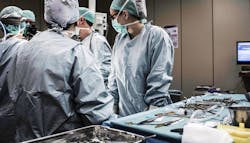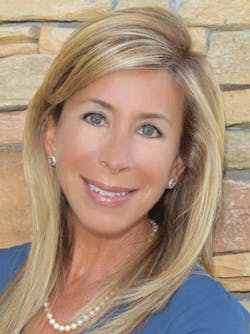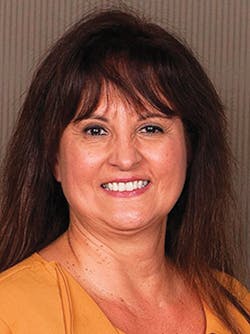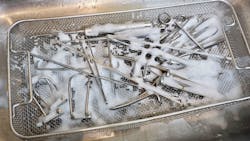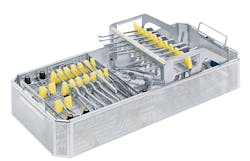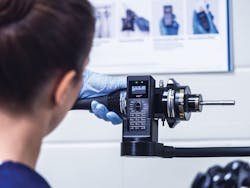Two of the areas in a medical facility that benefit most from collaboration are the operating room (OR) and sterile processing departments (SPDs). Unfortunately, good working relationships are not always in place between these two departments. Healthcare Purchasing News looked into some of the issues as to why this is, and what are some of the perceived barriers, as well as how an effective approach to collaboration can defuse tension between the two departments while improving patient care and preserving expensive surgical instruments.
“’Teamwork makes the dream work,’” according to noted leadership coach and author John C. Maxwell,” related Lynn Burbank DNP, RN, CRNP, Senior Manager, Infection Prevention, Olympus Corporation of the Americas. “However, when the team has issues, it can be a nightmare. Teamwork is necessary for successful completion of all steps in the processes required to care for patients undergoing surgery or diagnostic and interventional procedures. The cornerstone for teamwork is collaboration, which is foundational to patient safety, maintaining high-quality care, and creating employee satisfaction.”
Duberman cited the following causes of poor relations between departments:
- Misunderstanding: Both departments face unique challenges in their daily operations, yet neither understands the other’s challenges.
- Size: As the size of the hospital grows, the distance between the two teams also increases and becomes more complex, resulting in poor information flow.
- Silos: SPD teams are often located in the facility basement whereas the OR is dispersed across several floors, leading to a disconnect in communication.
“Fortunately, collaboration efforts can break down barriers and promote effective communication for better outcomes,” continued Duberman. “The overall goal of interdepartmental collaboration is to develop open communication and build trust to create an alignment to help improve patient satisfaction and outcomes, create a safer environment, enhance quality of care, and reduce clinical errors.”
Duberman offered tips as to how to achieve better communication toward collaboration:
- Interactions: Management should be intentional about including both teams in staff meetings, celebrations, and functions. The more interactions team members have, the more likely they will be to collaborate on issues.
- Education: Cross-training SPD staff allows the team to develop organizational awareness, understand the purpose of the instruments they are cleaning, and reprioritize more accurately.
- Align Leaders: Leadership on both teams should be aligned through regular meetings to strengthen teamwork and ensure each team has the resources they need. Leadership should also agree on overlapping goals, work to develop and maintain collaboration, agree on expectations, and define metrics of success.
- Policies: Management should invite both teams’ input into processes that impact both departments, such as instrument-processing workflows or the purchasing of new devices that will affect the workflow. Both teams should be consulted on final process decisions and agree on how tools are used.
Berling described HEINE’s EasyClean laryngoscope handle as designed to provide the best performing product for the OR and simplest, most efficient and effective reprocessing process for SPD for reliable and safe intubation for the patient.”
Jean Sargent, President, Sargent Healthcare Strategies, suggested analyzing the problem to arrive at a solution rather than pointing fingers.“Accepting responsibility is another big problem on both sides,” added Sargent. “Unfortunately, we lose sight of the fact that we are all here for patient care, and we must strive to improve.”
Miller noted, “Another issue I’ve witnessed is the perceived notion that, somehow, working as an inter-professional team will lead to a loss of autonomy, which ultimately adds fuel to the fire of the territorialism and incivility that is so prevalent in the perioperative arena. Unfortunately, this attitude has led to a lack of awareness regarding the education, knowledge, and skills held by colleagues from other disciplines as well as very little confidence or trust in decisions made by others outside their respective departments. This is due to years of haphazard communication, collaboration, cooperation, coordination, and [a lack of] mutual support and respect that has been tolerated and accepted as normal behavior.”
Miller said Circle of Care’s “goal is to enhance communication and education across all disciplines, to help break down silos, and to improve quality patient care. We are devoted to the development of teamwork; focusing primarily on highly effective medical teams that optimize the use of information, people, and resources to achieve the best clinical outcomes for patients.”
Paul Hodge, Marketing Manager, Health Systems Consulting, Aesculap, highlighted the need for communication and interaction between not just the departments but among involved individuals. “Allowing people to collaborate and share experiences is critical. We see many hospitals that integrate SPD and OR. At a minimum, we recommend dedicated time to share challenges faced by each group. Ideally, this is supported by data that define and refine processes. The SPD is a critical cog in the complex world of the modern surgical theater. The teams should continually work as one cohesive unit to promote a healthy and continually improving environment of care.”
Marcia Frieze, CEO, Case Medical, Inc., also had a recommendation for involved individuals. “Cross-departmental work-shadowing is a great way to improve understanding between perioperative and sterile-processing personnel. Once you’ve seen and experienced something yourself, it can change your attitudes, perceptions, and beliefs.”
Managing processes and caring for the investment
Sargent addressed the financial aspect of managing the facility’s investment in expensive surgical instruments. She said, “A facility’s total value of instrumentation, including scopes, is in the million-dollar level. Many do not realize the impact of neglect in managing and maintaining this asset. Replacement, refurbishment, and preventive maintenance are a significant budget impact each fiscal year. Educating all users—clinicians, physicians, scrub techs, floor nurses, and SPD techs—is essential in providing an understanding of costs, appropriate care and handling, and cost savings associated with the efforts by all.”
Sargent pointed to simple strategies that can save expenses. “A review of instrument use by tray is something that many organizations do not take the time to do. Right-sizing instrument trays addresses many concerns such as unnecessary reprocessing of instruments, which at some point will need to be replaced; the time to count unused instruments in the OR; the space to st.ore oversize trays; the number of peel-packed items to have on hand that are used routinely.
“The efficiencies for the OR and SPD staff are significant,” continued Sargent, noting that the cost reduction in placing more instruments back on the rack for future use allows for purchase of expensive instruments that are fewer on hand than needed. “Physician involvement creates collaboration and good will, while standardizing also works toward a standard of care. This process is for the good of all, especially the patient.”
Turnover and ensuring correct instrument sets are delivered
BD offers a solution. “BD offers technology that helps hospitals manage and improve perioperative processes. The IMPRESS Asset Management System is a software solution that enables greater efficiency between the SPD and OR while improving patient safety and regulatory compliance.” Here is how it works, explained VanVoorhees. “The IMPRESS System tracks instrument trays to the patient level and prioritizes reprocessing based on the hospital’s surgery schedule. With near real-time data, the SPD is able automatically to prioritize trays that require quick turnaround, while the OR staff is quickly able to locate instruments on emergency-case carts when needed unexpectedly. This fluidity of information between departments helps create efficiencies through better communication and data access.
“In conjunction with its products,” added VanVoorhees, “BD offers the BD Power in Prevention program, a complimentary product support program that helps identify opportunities to standardize processes, improve efficiency, and adhere to evidence-based practices that ensure appropriate use of BD products within the OR and SPD. As part of Power in Prevention, BD conducts a practice assessment and provides tailored recommendations for education on BD products to improve practices across teams. This may help minimize stress between teams for process-related errors such as bioburden on instruments or on-time delivery of accurate, sterile instrument trays.”
Hodge, Aesculap, also addressed the issue of not having the correct instrument sets ready when needed. “A variety of factors contribute to this, including loaner trays. Staff may rush to get them processed in time, while many trays are labeled by hand, based on what the technician read on the external packaging. Differences in terminology can generate miscommunication and confusion. Combine this with mass production on a busy day when hundreds of other trays are jockeying for position in decontamination, and the situation can quickly become chaotic and disordered. “
“Inclusion and communications are the key to assuring the correct sets are delivered to the OR when they need them,” stated Gibbs, Altru Health System. “Turnover concerns are constant in this industry.” Gibbs said their CSD has a strategy to prevent this. They have daily huddles between the teams to look at the next day’s schedule and instrument turnover. “The OR relies on the CSD to bring forward pain points in the future day’s schedule and be part of the solution. Together they work to make any adjustments to the schedule. We also have created an OR liaison position within the CSD. There are two scheduled every day, one in the CSD and the other in the OR workroom. It makes a cohesive communication loop between the departments with highly skilled techs that know both areas. They manage the flow of instruments between the departments and have oversight of the instrument flow through the CSD. We can be those customer-service champions right in their department.”
David Anbari, CEO, Mobile Instrument Service & Repair, Inc., also recommends meetings be held prior to needs. “Where we see issues is when there are emergency cases added and the inventory is too thin for the unexpected demand. There’s also a belief that it is ok to have backlog in SPD. Holding periodic, quick, stand-up meetings with supervisors and team leads can help identify backlogs quickly and allow for adjusting staff coverage accordingly. Without information flow from this communication, it is difficult to take proactive action. We think a best practice is to better align inventory to demand, including some provision for unexpected cases, and to adjust staff in each unit within SPD to clear reprocessing backlog more quickly.”
“The pressure to speed up OR turnover and instrument processing is felt by everyone involved in the perioperative workflow,” observed Frieze, Case Medical. “Often, department members don’t understand the complexity of the work their counterparts perform or how each step affects the next. With point-of-use cleaning, we have an opportunity to improve outcomes by pretreating instruments to prevent the formation of biofilm, support the remainder of the instrument processing workflow, and comply with applicable standards and guidelines from AAMI and AORN.
“Investing in reusable containers customized to protect expensive and delicate surgical instruments makes good financial sense,” averred Frieze. “When compared to blue wrap, rigid containers offer superior instrument protection without the risk of tears or holes that may delay surgery or necessitate the use of immediate-use steam sterilization. You also eliminate blue wrap from the biohazard waste stream, which reduces costs and is an excellent sustainability initiative.”
Importance of point-of-use pre-cleaning
Hodge, Aesculap, talked about another complaint sometimes heard from SPD: instruments come back to the SPD crusted with bioburden, which could be avoided if the proper steps were followed before instruments are transported back to the SPD. ”In our observations, many facilitates may not enforce or hold staff accountable for basic removal of gross bioburden and treatment of surgical assets with pre-treatment chemistries at the point of use. Furthermore, many may not be informed of the consequences of biofilm development, the corrosive effects of blood, and, in some cases, OR pharmaceuticals.”
Frieze, Case Medical, agreed that treatment to remove bioburden at point of use is critical. “Point-of-use treatment, particularly with an enzymatic formula like PentaPrep Multi-Enzymatic Solution, helps speed up the decontamination process by breaking down bioburden and reduces the risk of patients being exposed to inadequately processed instruments.” Frieze suggested, for more efficiency, the Fast Foam Spray System be installed in ORs or attached to a rolling IV pole to move between rooms.
Addressing costs, Frieze explained, “We’ve found that when facilities analyze the costs associated with blue wrap or with some competitive containers that are easily damaged or not customized to the surgical set, there is ample opportunity for cost savings. We offer a financial analysis to help make comparisons based on total cost of use or ownership, and we find that our durable SteriTite containers tend to pay for themselves in under a year.”
Gibbs, Altru Health System, explained her facility’s position. “The Central Sterile and Surgery leadership teams are partners. We model and have created a cohesive, collaborative culture between our departments. It is the expectation of the OR to follow standards and to have the instruments free of gross debris and a pre-treatment applied when they send them to decontam. It is the expectation of the CSD team to provide appropriate feedback when this doesn’t happen, so it can be corrected in the moment in a non-punitive, but educational manner. All members of the OR and CSD teams work collaboratively to assure this standard work is followed for the safety of our team members and the patients.”
Avoiding damage to expensive instruments
Another major issue is damage of expensive surgical instruments. Hodge, Aesculap, stated, “Most wear and tear of surgical instruments comes from improper handling. Typically, the process begins in the OR where trays are mixed up and thrown into a return bin or container basket. This may result in the dumping of surgical trays to remove the risk associated with sharp objects during the decontamination process, further damaging the instruments. Hospitals that employ a basic return protocol in a structured and safe manner will eliminate a great deal of excessive damage.”
Hodge pointed out, “Process and procedures are paramount to successful SPD/OR operations. Properly sized containers with attention to the details of the layout and use of instrument organizational systems also contributes to optimized flow.” He described their solution. “Aesculap Technical Services is designed to preserve the quality and extend the value of surgical instrumentation. Aesculap’s instrument repair and refurbishment ensures that every instrument functions properly and is fit for surgical use when required. An instrument preventative maintenance program is imperative to maintain the surgical fleet in top working condition and to extend the useful life of those assets. By taking a proactive approach to maintenance, you will identify risk earlier in the life cycle of the fleet. This will keep your repair cost to a minimum and promote overall satisfaction with the OR staff.“
Anbari, Mobile Instrument Service & Repair, Inc., reiterated the importance of pre-cleaning surgical instruments and consequences of failure to do so. “Failure to properly pre-clean instruments after a case in the OR is a very common deficiency that not only degrades an instrument rapidly but also causes extra cleaning in decontamination in the SPD. In our experience, this poor practice can be corrected simply by raising awareness in the OR. It doesn’t require punitive actions, just a gentle reminder and an explanation of the downstream impact when proper protocol is not followed.
“When damaged instruments reach the OR, it means that there has been a failure someplace in the process. Between inspections in SPD during assembly and in the OR before use, it ought to be a rare occurrence that a non-usable instrument makes it into a surgeon’s hands. It is critical that anyone who identifies an instrument that is not patient-ready pull that instrument from circulation and identify it as needing repair. The most common causes of damage to instruments are using an instrument other than for its intended purpose (eg, cutting metal pins); piling or stacking instruments during reprocessing; failure to pre-clean instruments before they go to decontam; and failure to ensure sterilizers and washers are working optimally with clean water sources.
“Historically, our service has been viewed as a reactive one: when things break, we fix them,” said Anbari. “Of course, instruments will always break or degrade over time, and the minimum expectation is that the damaged items get fixed or replaced; however, when instrument readiness improves, clinicians are happy, patients get better and safer care, and overall spend on instruments declines. There are few areas in a care setting where you can spend less and get better outcomes.
“It takes time to build a complete preventative maintenance program,” said Anbari, “and the one thing that is in less supply in healthcare than money seems to be patience. Hospitals that embrace a complete preventative maintenance program get the benefits over time. Combine the core service with focused advice and education for hospital staff and we can really bend the cost curve for our customers.”
Gibbs, Altru Health System, offered advice on caring for expensive surgical instruments. “We need to be stewards of instruments for financial reasons and for our patients. We all have duty to ensure we have perfectly performing instruments. Our surgeons and patients deserve it. We need to follow the instructions for use for reprocessing and always handle them with care. We need to protect them. If you are seeing damage, look and assess how they are being held in the pans. Are they getting hooked, bumped, and banged through normal transportation or washer processes? Products like the Instrusafe custom pans reduce the risk and make it easy for staff to do the right thing. Investments in products like this are investments in our instruments and our employees.”
Burbank, Olympus Corporation of the Americas, explained that reducing human factors by means of automation in the processes enhances collaboration and care. “In the daily management of patients undergoing complex procedures, effective collaboration between all of the necessary teams or working groups can be difficult and is affected by human factors, or the ‘human-ness’ in a process. Reducing human factors is an effective intervention in minimizing risk to the patient and in enhancing collaboration between teams.
“Automation of steps in a process is one method to eliminate human-ness in an action. Automation supports staffing, time management, documentation, data analysis, and, most critically, collaboration. Implementation of a tool that is designed to identify participants in a procedure, facilitate timely documentation, record damage to instruments or devices, and track time between steps in the process has the potential to enhance collaboration between teams and to improve care.
“Utilization of data generated through automation of processes allows OR, procedural suite, and SPD staff opportunities to identify where communication can be enhanced and potential for error can be minimized,” continued Burbank. “Data generated by a software platform such as Unifia allows staff to examine the various steps in reprocessing flexible endoscopes. Each stage in a process can be tracked, facilitating audits to assess areas for improvement. Evidence from AORN and The Joint Commission supports auditing as a method for quality improvement and reduction of risk in healthcare.”
About the Author
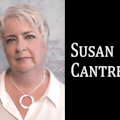
Susan Cantrell
Susan Cantrell is Infection Prevention Editor for Healthcare Purchasing News.
